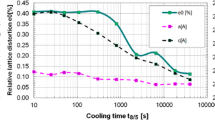Abstract
The extent of hydrogen embrittlement phenomenon is dependent on the interaction of hydrogen with the material i.e. diffusion behavior, lattice distortions, phase transformations and residual stresses developments. For the better understanding of the hydrogen interaction with the metal, possibilities of performing in-situ observations of the mentioned factors has to be accomplished. The EDDI (Energy Dispersive Diffraction) beamline at the BESSY II facility in Berlin provides this possibility and was used in order to investigate the aspects of this phenomenon in in-situ scale.
The energy dispersive method entails a synchrotron X-ray white beam with a wide energy range (20–120 keV) which allows a fixed position of the sample and the detector, and combined with the high photons flux it allows a very short measurement time for obtaining a full scale X-Ray Diffraction patterns.
In this contribution, the successful usage of high energy X-rays, applied for the first time for hydrogen behavior observations, provided the ability for evaluating in-situ the hydrogen diffusion behavior and the hydrogen interaction with stresses fields in the material.
Steel samples were charged with hydrogen and examined by Synchrotron radiation.
Two different methods were used in this research; the first is diffusible hydrogen concentration evaluation extracted from the lattice distortions, i.e. changes of the lattice parameter. The second is calculation of the residual stresses present in the sample and the interaction of hydrogen with them, using the known sin2ψ method.
Access this chapter
Tax calculation will be finalised at checkout
Purchases are for personal use only
Preview
Unable to display preview. Download preview PDF.
Similar content being viewed by others
References
A. Troiano, “The role of hydrogen and other interstitials in the mechanical behavior of metals,” trans. ASM, vol. 52, pp. 54–80, 1960.
R. A. Oriani, “A mechanistic theory of hydrogen embrittlement of steels,” Berichte der Bunsengesellschaft für physikalische …, pp. 848–857, 1972.
C. Zapffe, “Hydrogen embrittlement, internal stress and defects in steel,” Hydrogen damage: a discriminative selection of outstanding articles and papers from the scientific literature, p. 13, 1977.
R. A. Oriani, “Hydrogen embrittlement of steels,” Annual review of materials science, vol. 8, no. 4070, pp. 327–57, Jan. 1978.
R. F. M. Medalist, “Effects of Hydrogen on the Properties of Iron and Steel,” vol. 11, no. June, 1980.
W. Johnson, “On some remarkable changes produced in iron and steel by the action of hydrogen and acids,” Proceedings of the Royal Society of London, vol. 23, pp. 168–179, 1874.
C. Beachem, “A new model for hydrogen-assisted cracking (hydrogen ‘embrittlement’),” Metallurgical and Materials Transactions B, vol. 3, pp. 437–451, 1972.
H. K. Birnbaum and P. Sofronis, “Hydrogen-enhanced localized plasticity—a mechanism for hydrogen-related fracture,” Materials Science and Engineering: A, vol. 176, pp. 191–202, 1994.
H. Lü, M. Li, T. Zhang, and W. Chu, “Hydrogen-enhanced dislocation emission, motion and nucleation of hydrogen-induced cracking for steel,” Science in China Series E: Technological Sciences, vol. 40, no. 5, pp. 530–538, Oct. 1997.
S. Lee and D. Unger, “A decohesion model of hydrogen assisted cracking,” Engineering fracture mechanics, vol. 31, no. 4, pp. 647–660, 1988.
X. L. Han, Q. Wang, D. L. Sun, T. Sun, and Q. Guo, “First-principles study of hydrogen diffusion in alpha Ti,” International Journal of Hydrogen Energy, vol. 34, no. 9, pp. 3983–3987, May 2009.
H. Wipf, B. Kappesser, and R. Werner, “Hydrogen diffusion in titanium and zirconium hydrides,” Journal of Alloys and Compounds, vol. 310, no. 1–2, pp. 190–195, Sep. 2000.
E. Fallahmohammadi, F. Bolzoni, and L. Lazzari, “Measurement of lattice and apparent diffusion coefficient of hydrogen in X65 and F22 pipeline steels,” … Journal of Hydrogen Energy, 2012.
C. Genzel, I. a. Denks, J. Gibmeier, M. Klaus, and G. Wagener, “The materials science synchrotron beamline EDDI for energy-dispersive diffraction analysis,” Nuclear Instruments and Methods in Physics Research Section A: Accelerators, Spectrometers, Detectors and Associated Equipment, vol. 578, no. 1, pp. 23–33, Jul. 2007.
“ISO DIS 3690: Welding and allied processes: Determination of hydrogen content in ferritic steel arc weld metal,” 2009.
M. Klaus, C. Genzel, and H. Holzschuh, “Residual stress depth profiling in complex hard coating systems by X-ray diffraction,” Thin Solid Films, vol. 517, no. 3, pp. 1172–1176, Dec. 2008.
E. Macherauch and P. Müller, “Das sin2psi Verfahren der Röntgenographischen Spannungsmessung,” Zeitschrift für angewandte Physik, vol. 13, no. 7, pp. 305–312, 1961.
I. M. Robertson and H. K. Birnbaum, “DISLOCATION MOBILITY AND HYDROGEN,” Materials Research.
I. M. Robertson, “The effect of hydrogen on dislocation dynamics,” Engineering Fracture Mechanics, vol. 64, pp. 649–673, 1999.
E. Dabah, T. Kannengiesser, D. Eliezer, and T. Boellinghaus, “In situ analysis of hydrogen behaviour in stainless steels by high energy synchrotron radiation,” Materials Science and Engineering A, vol. 528, no. 3, pp. 1608–1614, Jan. 2011.
Author information
Authors and Affiliations
Editor information
Editors and Affiliations
Rights and permissions
Copyright information
© 2013 TMS (The Minerals, Metals & Materials Society)
About this paper
Cite this paper
Kannengiesser, T., Dabah, E. (2013). Energy Dispersive Synchrotron Diffraction for In-Situ Analyses of Hydrogen Behavior in Steels. In: Marquis, F. (eds) Proceedings of the 8th Pacific Rim International Congress on Advanced Materials and Processing. Springer, Cham. https://doi.org/10.1007/978-3-319-48764-9_431
Download citation
DOI: https://doi.org/10.1007/978-3-319-48764-9_431
Publisher Name: Springer, Cham
Print ISBN: 978-3-319-48586-7
Online ISBN: 978-3-319-48764-9
eBook Packages: Chemistry and Materials ScienceChemistry and Material Science (R0)




